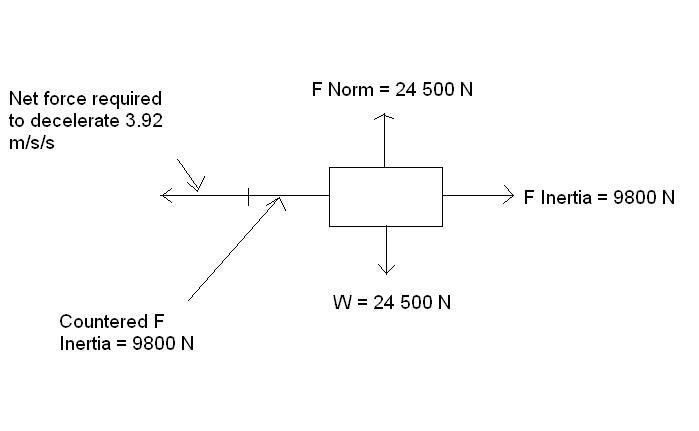 |
|
| Browse | Ask | Answer | Search | Join/Login |
|
- F = m*a = (2500.0 kg)(-3.92 m/s/s) = -9800 N
- F net = m*a = (2500.0 kg)(-3.92 m/s/s) = -9800 N
- Coefficient = F friction / F normal = (-19 600) / (24 500) = -0.8
|
||||
|
Friction When Skidding
You are driving a 2500.0 kg car at a constant speed of 14.0 m/s along an icy, but straight and level road. While approaching a traffic light, it turns red. You slam on the brakes. Your wheels lock, the tires begin skidding, and the car slides to a halt in a distance of 25.0 m. What is the coefficient of sliding friction between your tires and the icy roadbed? Include a free body diagram.
For this question I only have the normal force in the equation F friction = F normal * coefficient, so I have to figure out the force of friction, which will be the net force located on the left of my free body diagram. I'm guessing the only force acting on the right would be inertia, which would be: I assume the force of friction on the locked tires and icy roadbed has to overcome the force of inertia plus the extra needed to accelerate at -3.92 m/s/s. So the force of friction is twice the size of inertia pushing on the car as it tries to stop, making it -19 600 N. Now that I have this force, I can find the coefficient. Ignoring the negatives I attempted to make use of, I get 0.8 which seems a bit high, doesn't it? Where did I go wrong?  Here are my questions: 1) Did I do this wrong? 2) What would be the correct use of negative signs to display direction? I think I confused myself by trying. |
||||
|
||||
|
Well, I have to go to bed, so I'll leave you this to think over: the immediate glaring problem is this "force due to inertia" you have.
Newton told us that a body remains at constant velocity unless a force acts on it. i.e. force creates an acceleration. I don't see where this forward force you have put on your free body diagram is coming from in the situation of the car braking and skidding, as it is not accelerating forwards. This is a common misunderstanding. There is no forward force on a car at a constant velocity (ignoring friction). This "F Inertia" doesn't exist. The only way a forward force could be created would be from the engine. But in a braking situation the engine is not doing anything. Think about it and you'll see that this F inertia is wrong. I'll be back in the morning :) |
||||
|
||||
|
You did fine, right up to the factor of 2 multiplier. Your "F net" is correct - that's the force that the friction applies to the car to slow it down. So all you need is:
Coefficient = F net/F normal Another way to do this problem is by determing the work the friction force needs to do to equal the initial kinetic energy of the car: Here the force is applied by friction, which is: |
||||
| Question Tools | Search this Question |
Add your answer here.
Check out some similar questions!
I am doing my physic coursework and have to explain why the greater the mass, the greater the frictional force,that the more uneven the surface the more frictional force and finally the greater the surface area the greater the friction. Please help it is for my coursework.
:confused: :confused: A force of 30.0 N is required to start a 4.4 kg box moving across a horizontal concrete floor. (a) What is the coefficient of static friction between the box and the floor? (b) If the 30.0 N force continues, the box accelerates at 0.50 m/s2. What is the coefficient of...
Found Them... Thanks To Myself.
A 200-N sled is pushed along a horizontal surface at constant speed with a 50-N force that makes an angle of 28 degrees below the horizontal. What is the coefficient of kinetic fricition?
Hi guyz and girlz! What an amazing site it is! Believe it or not I was searchin for some sciecetific sites such as this Here is this In front of my eyez Well dears
View more questions Search
|





